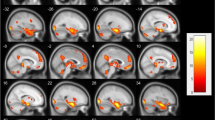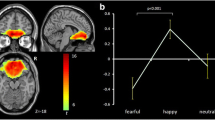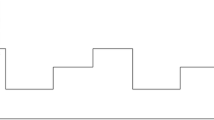Abstract
This fMRI study examined whether hemodynamic responses to affectively-salient stimuli were abnormally prolonged in remitted bipolar disorder, possibly representing a novel illness biomarker. A group of 18 DSM-IV bipolar I-diagnosed adults in remission and a demographically-matched control group performed an event-related fMRI gender-discrimination task in which face stimuli had task-irrelevant neutral, happy or angry expressions designed to elicit incidental emotional processing. Participants’ brain activation was modeled using a “fully informed” SPM5 basis set. Mixed-model ANOVA tested for diagnostic group differences in BOLD response amplitude and shape within brain regions-of-interest selected from ALE meta-analysis of previous comparable fMRI studies. Bipolar-diagnosed patients had a generally longer duration and/or later-peaking hemodynamic response in amygdala and numerous prefrontal cortex brain regions. Data are consistent with existing models of bipolar limbic hyperactivity, but the prolonged frontolimbic response more precisely details abnormalities recognized in previous studies. Prolonged hemodynamic responses were unrelated to stimulus type, task performance, or degree of residual mood symptoms, suggesting an important novel trait vulnerability brain dysfunction in bipolar disorder. Bipolar patients also failed to engage pregenual cingulate and left orbitofrontal cortex—regions important to models of automatic emotion regulation—while engaging a delayed dorsolateral prefrontal cortex response not seen in controls. These results raise questions about whether there are meaningful relationships between bipolar dysfunction of specific ventromedial prefrontal cortex regions believed to automatically regulate emotional reactions and the prolonged responses in more lateral aspects of prefrontal cortex.



Similar content being viewed by others
References
American Psychiatric Association, A.P. (2000). Diagnostic and statistical manual of mental disorders: DSM-IV-TR. Washington, DC: American Psychiatric Association.
Blumberg, H. P., Charney, D. S., & Krystal, J. H. (2002). Frontotemporal neural systems in bipolar disorder. Seminars in Clinical Neuropsychiatry, 7(4), 243–254.
Blumberg, H. P., Leung, H. C., Skudlarski, P., Lacadie, C. M., Fredericks, C. A., Harris, B. C., et al. (2003). A functional magnetic resonance imaging study of bipolar disorder: state- and trait-related dysfunction in ventral prefrontal cortices. Archives of General Psychiatry, 60(6), 601–609. doi:10.1001/archpsyc.60.6.601 60/6/601.
Blumberg, H. P., Donegan, N. H., Sanislow, C. A., Collins, S., Lacadie, C., Skudlarski, P., et al. (2005). Preliminary evidence for medication effects on functional abnormalities in the amygdala and anterior cingulate in bipolar disorder. Psychopharmacology, 183(3), 308–313. doi:10.1007/s00213-005-0156-7.
Bora, E., Yucel, M., & Pantelis, C. (2010). Neurocognitive markers of psychosis in bipolar disorder: a meta-analytic study. Journal of Affective Disorders, 127(1–3), 1–9. doi:10.1016/j.jad.2010.02.117.
Bozikas, V. P., Tonia, T., Fokas, K., Karavatos, A., & Kosmidis, M. H. (2006). Impaired emotion processing in remitted patients with bipolar disorder. Journal of Affective Disorders, 91(1), 53–56. doi:10.1016/j.jad.2005.11.013.
Calhoun, V. D., Stevens, M. C., Pearlson, G. D., & Kiehl, K. A. (2004). fMRI analysis with the general linear model: removal of latency-induced amplitude bias by incorporation of hemodynamic derivative terms. [Clinical Trial Research Support, Non-U.S. Gov’t]. NeuroImage, 22(1), 252–257. doi:10.1016/j.neuroimage.2003.12.029.
Cerullo, M. A., Adler, C. M., Delbello, M. P., & Strakowski, S. M. (2009). The functional neuroanatomy of bipolar disorder. International Review of Psychiatry, 21(4), 314–322. doi:10.1080/09540260902962107.
Chen, C. H., Lennox, B., Jacob, R., Calder, A., Lupson, V., Bisbrown-Chippendale, R., et al. (2006). Explicit and implicit facial affect recognition in manic and depressed States of bipolar disorder: a functional magnetic resonance imaging study. Biological Psychiatry, 59(1), 31–39. 10.1016/j.biopsych.2005.06.008.
Cohen, J. (1990). Statistical power analysis for the behavioral sciences (2nd ed.). Mahwah: Lawrence Erlbaum Associates, Inc.
Dolan, R. J. (2002). Emotion, cognition, and behavior. Science, 298(5596), 1191–1194. doi:10.1126/science.1076358 298/5596/1191.
First, M.B., Spitzer, R.L., Gibbon, M., & Williams, J.B.W. (2002). Structured clinical interview for DSM-IV-TR axis I disorders, research version, patient edition (SCID-I/P). New York: Biometrics Research, New York State Psychiatric Institute.
Freire, L., Roche, A., & Mangin, J. F. (2002). What is the best similarity measure for motion correction in fMRI time series? IEEE Transactions on Medical Imaging, 21(5), 470–484.
Friston, K. J., Fletcher, P., Josephs, O., Holmes, A., Rugg, M. D., & Turner, R. (1998). Event-related fMRI: characterizing differential responses. NeuroImage, 7(1), 30–40. doi:10.1006/nimg.1997.0306.
Fusar-Poli, P., Placentino, A., Carletti, F., Landi, P., Allen, P., Surguladze, S., et al. (2009). Functional atlas of emotional faces processing: a voxel-based meta-analysis of 105 functional magnetic resonance imaging studies. Journal of Psychiatry & Neuroscience, 34(6), 418–432.
Genovese, C. R., Lazar, N. A., & Nichols, T. (2002). Thresholding of statistical maps in functional neuroimaging using the false discovery rate. NeuroImage, 15(4), 870–878.
Getz, G. E., Shear, P. K., & Strakowski, S. M. (2003). Facial affect recognition deficits in bipolar disorder. Journal of the International Neuropsychological Society, 9(4), 623–632. doi:10.1017/S1355617703940021.
Glahn, D. C., Bearden, C. E., Niendam, T. A., & Escamilla, M. A. (2004). The feasibility of neuropsychological endophenotypes in the search for genes associated with bipolar affective disorder. Bipolar Disorders, 6(3), 171–182. doi:10.1111/j.1399-5618.2004.00113.x.
Green, M. J., Cahill, C. M., & Malhi, G. S. (2007). The cognitive and neurophysiological basis of emotion dysregulation in bipolar disorder. Journal of Affective Disorders, 103(1–3), 29–42. doi:10.1016/j.jad.2007.01.024.
Handwerker, D. A., Gonzalez-Castillo, J., D’Esposito, M., & Bandettini, P. A. (2012). The continuing challenge of understanding and modeling hemodynamic variation in fMRI. [Historical Article Research Support, N.I.H., Intramural Review]. NeuroImage, 62(2), 1017–1023. doi:10.1016/j.neuroimage.2012.02.015.
Hassel, S., Almeida, J. R., Kerr, N., Nau, S., Ladouceur, C. D., Fissell, K., et al. (2008). Elevated striatal and decreased dorsolateral prefrontal cortical activity in response to emotional stimuli in euthymic bipolar disorder: no associations with psychotropic medication load. Bipolar Disorders, 10(8), 916–927. doi:10.1111/j.1399-5618.2008.00641.x.
Henry, C., M’Bailara, K., Mathieu, F., Poinsot, R., & Falissard, B. (2008a). Construction and validation of a dimensional scale exploring mood disorders: MAThyS (Multidimensional Assessment of Thymic States). BMC Psychiatry, 8, 82. doi:10.1186/1471-244X-8-82.
Henry, C., Van den Bulke, D., Bellivier, F., Roy, I., Swendsen, J., M’Bailara, K., et al. (2008b). Affective lability and affect intensity as core dimensions of bipolar disorders during euthymic period. Psychiatry Research, 159(1–2), 1–6. doi:10.1016/j.psychres.2005.11.016.
Henson, R. (2003). Ananlysis of fMRI time series. In R. S. Frackowiak, K. J. Friston, C. Frith, R. Dolan, C. J. Price, J. Zeki, et al. (Eds.), Human Brain Function (2nd ed.): Academic Press.
Henson, R., & Friston, K. (2007). Convolution models for fMRI. In K. Friston, J. Ashburner, S. Kiebel, T. E. Nichols, & W. Penny (Eds.), Statistical parametric mapping: The analysis of functional brain images (pp. 178–192). London: Academic Press.
Henson, R. N., Price, C. J., Rugg, M. D., Turner, R., & Friston, K. J. (2002). Detecting latency differences in event-related BOLD responses: application to words versus nonwords and initial versus repeated face presentations. [Research Support, Non-U.S. Gov’t]. NeuroImage, 15(1), 83–97. doi:10.1006/nimg.2001.0940.
Lagopoulos, J., & Malhi, G. S. (2007). A functional magnetic resonance imaging study of emotional Stroop in euthymic bipolar disorder. Neuroreport, 18(15), 1583–1587. doi:10.1097/WNR.0b013e3282efa07a.
Laird, A. R., Fox, P. M., Price, C. J., Glahn, D. C., Uecker, A. M., Lancaster, J. L., et al. (2005). ALE meta-analysis: controlling the false discovery rate and performing statistical contrasts. Human Brain Mapping, 25(1), 155–164. doi:10.1002/hbm.20136.
Lawrence, N. S., Williams, A. M., Surguladze, S., Giampietro, V., Brammer, M. J., Andrew, C., et al. (2004). Subcortical and ventral prefrontal cortical neural responses to facial expressions distinguish patients with bipolar disorder and major depression. Biological Psychiatry, 55(6), 578–587. doi:10.1016/j.biopsych.2003.11.017.
Lembke, A., & Ketter, T. A. (2002). Impaired recognition of facial emotion in mania. The American Journal of Psychiatry, 159(2), 302–304.
Lindquist, M. A., Meng Loh, J., Atlas, L. Y., & Wager, T. D. (2009). Modeling the hemodynamic response function in fMRI: efficiency, bias and mis-modeling. NeuroImage, 45(1 Suppl), S187–S198. doi:10.1016/j.neuroimage.2008.10.065.
Lundquist, D., Flykt, A., & Öhman, A. (1998). The Karolinska Directed Emotional Faces of Emotion and Attention Stockholm, Sweden: Lawrence.
Malhi, G. S., Lagopoulos, J., Owen, A. M., Ivanovski, B., Shnier, R., & Sachdev, P. (2007). Reduced activation to implicit affect induction in euthymic bipolar patients: an fMRI study. Journal of Affective Disorders, 97(1–3), 109–122. doi:10.1016/j.jad.2006.06.005.
M’Bailara, K., Demotes-Mainard, J., Swendsen, J., Mathieu, F., Leboyer, M., & Henry, C. (2009). Emotional hyper-reactivity in normothymic bipolar patients. Bipolar Disorders, 11(1), 63–69. doi:10.1111/j.1399-5618.2008.00656.x.
McClure, E. B., Pope, K., Hoberman, A. J., Pine, D. S., & Leibenluft, E. (2003). Facial expression recognition in adolescents with mood and anxiety disorders. The American Journal of Psychiatry, 160(6), 1172–1174.
Morris, J. S., Frith, C. D., Perrett, D. I., Rowland, D., Young, A. W., Calder, A. J., et al. (1996). A differential neural response in the human amygdala to fearful and happy facial expressions. Nature, 383(6603), 812–815. doi:10.1038/383812a0.
Murphy, F. C., Nimmo-Smith, I., & Lawrence, A. D. (2003). Functional neuroanatomy of emotions: a meta-analysis. Cognitive, Affective, & Behavioral Neuroscience, 3(3), 207–233.
Myin-Germeys, I., Peeters, F., Havermans, R., Nicolson, N. A., DeVries, M. W., Delespaul, P., et al. (2003). Emotional reactivity to daily life stress in psychosis and affective disorder: an experience sampling study. Acta Psychiatrica Scandinavica, 107(2), 124–131.
Nock, M. K., Wedig, M. M., Holmberg, E. B., & Hooley, J. M. (2008). The emotion reactivity scale: development, evaluation, and relation to self-injurious thoughts and behaviors. Behavior Therapy, 39(2), 107–116. doi:10.1016/j.beth.2007.05.005.
Ochsner, K. N., & Gross, J. J. (2005). The cognitive control of emotion. Trends in Cognitive Sciences, 9(5), 242–249. 10.1016/j.tics.2005.03.010.
Ollinger, J. M., Corbetta, M., & Shulman, G. L. (2001). Separating processes within a trial in event-related functional MRI. [Clinical Trial Research Support, Non-U.S. Gov’t Research Support, U.S. Gov’t, P.H.S.]. NeuroImage, 13(1), 218–229. doi:10.1006/nimg.2000.0711.
Orsillo, S. M., Theodore-Oklota, C., Luterek, J. A., & Plumb, J. (2007). The development and psychometric evaluation of the emotional reactivity and numbing scale. The Journal of Nervous and Mental Disease, 195(10), 830–836. doi:10.1097/NMD.0b013e318156816f.
Pavuluri, M. N., O’Connor, M. M., Harral, E., & Sweeney, J. A. (2007). Affective neural circuitry during facial emotion processing in pediatric bipolar disorder. Biological Psychiatry, 62(2), 158–167. doi:10.1016/j.biopsych.2006.07.011.
Pavuluri, M. N., O’Connor, M. M., Harral, E. M., & Sweeney, J. A. (2008). An fMRI study of the interface between affective and cognitive neural circuitry in pediatric bipolar disorder. Psychiatry Research, 162(3), 244–255. 10.1016/j.pscychresns.2007.10.003.
Pavuluri, M. N., Passarotti, A. M., Harral, E. M., & Sweeney, J. A. (2009). An fMRI study of the neural correlates of incidental versus directed emotion processing in pediatric bipolar disorder. Journal of the American Academy of Child and Adolescent Psychiatry, 48(3), 308–319. 10.1097/CHI.0b013e3181948fc7.
Phan, K. L., Wager, T., Taylor, S. F., & Liberzon, I. (2002). Functional neuroanatomy of emotion: a meta-analysis of emotion activation studies in PET and fMRI. NeuroImage, 16(2), 331–348. doi:10.1006/nimg.2002.1087.
Phillips, M. L., Drevets, W. C., Rauch, S. L., & Lane, R. (2003). Neurobiology of emotion perception I: The neural basis of normal emotion perception. Biological Psychiatry, 54(5), 504–514.
Phillips, M. L., Ladouceur, C. D., & Drevets, W. C. (2008a). A neural model of voluntary and automatic emotion regulation: implications for understanding the pathophysiology and neurodevelopment of bipolar disorder. Molecular Psychiatry, 13(9), 829. doi:10.1038/mp.2008.65. 833–857.
Phillips, M. L., Travis, M. J., Fagiolini, A., & Kupfer, D. J. (2008b). Medication effects in neuroimaging studies of bipolar disorder. The American Journal of Psychiatry, 165(3), 313–320. doi:10.1176/appi.ajp.2007.07071066.
Pompili, M., Girardi, P., Tatarelli, R., Iliceto, P., De Pisa, E., Tondo, L., et al. (2008). TEMPS-A (Rome): psychometric validation of affective temperaments in clinically well subjects in mid- and south Italy. Journal of Affective Disorders, 107(1–3), 63–75. doi:10.1016/j.jad.2007.07.031.
Potash, J. B. (2006). Carving chaos: genetics and the classification of mood and psychotic syndromes. Harvard Review of Psychiatry, 14(2), 47–63. doi:10.1080/10673220600655780.
Rolls, E. T. (2000). Precis of the brain and emotion. The Behavioral and Brain Sciences, 23(2), 177–191. discussion 192–233.
Ruhe, H. G., Booij, J., Veltman, D. J., Michel, M. C., & Schene, A. H. (2011). Successful pharmacologic treatment of major depressive disorder attenuates amygdala activation to negative facial expressions: a functional magnetic resonance imaging study. The Journal of Clinical Psychiatry. doi:10.4088/JCP.10m06584.
Salzman, C. D., & Fusi, S. (2010). Emotion, cognition, and mental state representation in amygdala and prefrontal cortex. Annual Review of Neuroscience, 33, 173–202. doi:10.1146/annurev.neuro.051508.135256.
Savitz, J., & Drevets, W. C. (2009). Bipolar and major depressive disorder: neuroimaging the developmental-degenerative divide. Neuroscience and Biobehavioral Reviews, 33(5), 699–771. doi:10.1016/j.neubiorev.2009.01.004.
Siegle, G. J., Steinhauer, S. R., Thase, M. E., Stenger, V. A., & Carter, C. S. (2002). Can’t shake that feeling: event-related fMRI assessment of sustained amygdala activity in response to emotional information in depressed individuals. Biological Psychiatry, 51(9), 693–707.
Strakowski, S. M., Delbello, M. P., & Adler, C. M. (2005). The functional neuroanatomy of bipolar disorder: a review of neuroimaging findings. Molecular Psychiatry, 10(1), 105–116. doi:10.1038/sj.mp.4001585.
Surguladze, S. A., Marshall, N., Schulze, K., Hall, M. H., Walshe, M., Bramon, E., et al. (2010). Exaggerated neural response to emotional faces in patients with bipolar disorder and their first-degree relatives. NeuroImage, 53(1), 58–64. doi:10.1016/j.neuroimage.2010.05.069.
Tondo, L., Vazquez, G., & Baldessarini, R. J. (2010). Mania associated with antidepressant treatment: comprehensive meta-analytic review. Acta Psychiatr Scand, 121(6), 404–414, doi:10.1111/j.1600-0447.2009.01514.x.
Vonk, R., van der Schot, A.C., van Baal, G.C., van Oel, C.J., Nolen, W.A., & Kahn, R.S. (2011). Premorbid school performance in twins concordant and discordant for bipolar disorder. J Affect Disord, doi:10.1016/j.jad.2011.11.034.
Waugh, C. E., Hamilton, J. P., & Gotlib, I. H. (2010). The neural temporal dynamics of the intensity of emotional experience. NeuroImage, 49(2), 1699–1707. doi:10.1016/j.neuroimage.2009.10.006.
Wegbreit, E., Passarotti, A. M., Ellis, J. A., Wu, M., Witowski, N., Fitzgerald, J. M., et al. (2012). Where, when, how high, and how long? The hemodynamics of emotional response in psychotropic-naive patients with adolescent bipolar disorder. Journal of Affective Disorders. doi:10.1016/j.jad.2012.11.025.
Wessa, M., & Linke, J. (2009). Emotional processing in bipolar disorder: behavioural and neuroimaging findings. International Review of Psychiatry, 21(4), 357–367. doi:10.1080/09540260902962156.
Wessa, M., Houenou, J., Paillere-Martinot, M. L., Berthoz, S., Artiges, E., Leboyer, M., et al. (2007). Fronto-striatal overactivation in euthymic bipolar patients during an emotional go/nogo task. The American Journal of Psychiatry, 164(4), 638–646. doi:10.1176/appi.ajp.164.4.638.
Womer, F. Y., Kalmar, J. H., Wang, F., & Blumberg, H. P. (2009). A ventral prefrontal-amygdala neural system in bipolar disorder: A view from neuroimaging research. Acta Neuropsychiatr, 21(6), 228–238.
Woolrich, M. W., Behrens, T. E., & Smith, S. M. (2004). Constrained linear basis sets for HRF modelling using Variational Bayes. [Research Support, Non-U.S. Gov’t]. NeuroImage, 21(4), 1748–1761. doi:10.1016/j.neuroimage.2003.12.024.
Yarkoni, T., Barch, D. M., Gray, J. R., Conturo, T. E., & Braver, T. S. (2009). BOLD correlates of trial-by-trial reaction time variability in gray and white matter: a multi-study fMRI analysis. PLoS One, 4(1), e4257. doi:10.1371/journal.pone.0004257.
Yu, C., Zhou, Y., Liu, Y., Jiang, T., Dong, H., Zhang, Y., et al. (2011). Functional segregation of the human cingulate cortex is confirmed by functional connectivity based neuroanatomical parcellation. NeuroImage, 54(4), 2571–2581. doi:10.1016/j.neuroimage.2010.11.018.
Acknowledgments
This project was supported by awards R37MH043775, R01MH077945 (B-SNIP) and R01MH074797 from the National Institute of Mental Health (PI Pearlson). We would also like to thank the clinical staff that aided with data collection, including Karen Anderson, Mahvesh Ansari, Monika Czuchaw, Adrienne Gill and Kasey O’Neil.
Disclosures
Mr. Rosenfeld, Dr. Pearlson, Dr. Sweeney, Dr. Tamminga, Dr. Keshavan, Ms. Nonterah and Dr. Stevens have no competing interests.
Author information
Authors and Affiliations
Corresponding author
Additional information
Previous Presentations: This work was presented in part at the 66th Annual Meeting of the Society of Biological Psychiatry, May 12–14, 2011, San Francisco, CA, USA.
Electronic supplementary material
Below is the link to the electronic supplementary material.
ESM 1
(DOC 896 kb)
Rights and permissions
About this article
Cite this article
Rosenfeld, E.S., Pearlson, G.D., Sweeney, J.A. et al. Prolonged hemodynamic response during incidental facial emotion processing in inter-episode bipolar I disorder. Brain Imaging and Behavior 8, 73–86 (2014). https://doi.org/10.1007/s11682-013-9246-z
Published:
Issue Date:
DOI: https://doi.org/10.1007/s11682-013-9246-z




